Exploding Pumpkins and high-speed photography

Watch the video. Definitely one of the coolest projects I have ever worked on. We asked readers what worried them and then wrote those worries on pumpkins and blew them up! I felt like I was on the show Myth Busters all week. DO NOT TRY THIS AT HOME. All of these photos were taken under the supervision of experienced professionals.
Click the image above to watch the video on the Journal website.
Aside from the the joy of destroying pumpkins this also gave me a chance to take extreme high-speed photos. I’ve wanted to do this for a long time. You see when a flash is set to its lowest power setting the flash duration becomes extremely fast. On Kevin Lewis’ Blog I found that a Canon Speedlite at 1/128th power has a flash duration of 1/35,000 sec.
This means that whatever is caught by your flash is “frozen” at 1/35,000 sec since the flash is the only light exposing it. In order to do this though you need to keep the ambient light out either by shooting in the dark or shooting at a high aperture like f22 so the only light hitting the object is flash.
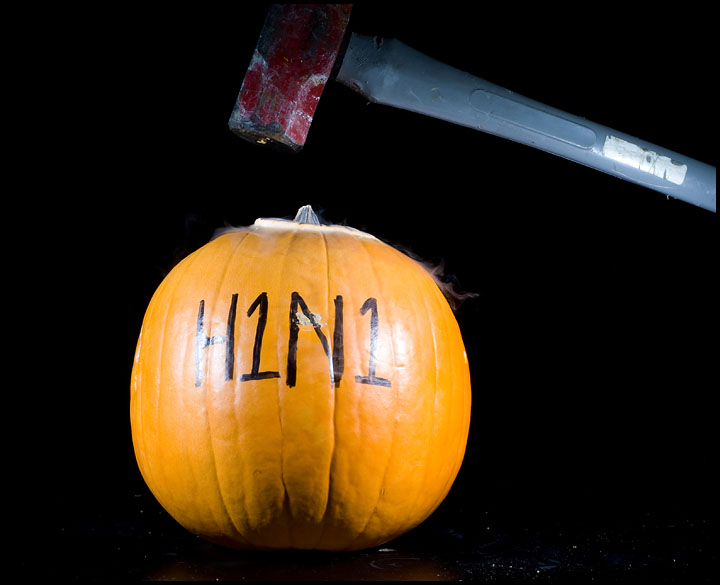
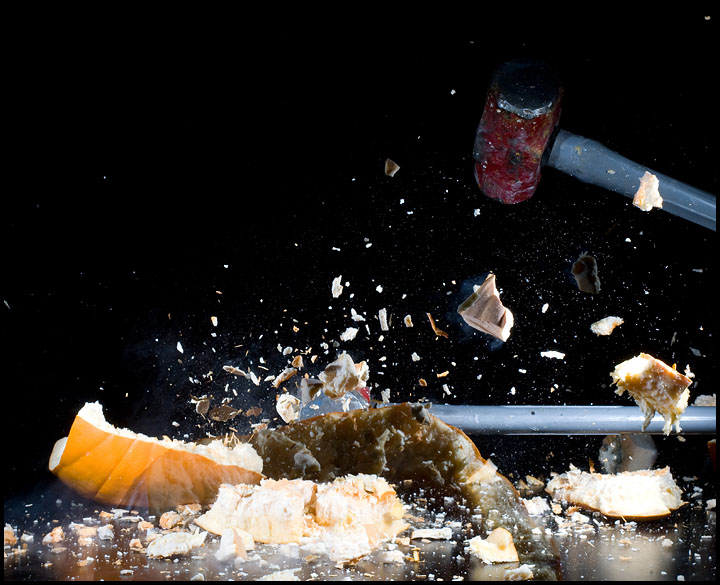
Here you see two hammers. That’s because the sound trigger set off the flash when the the hammer hit the pumpkin and then again when it hit the table. There was a 0.2 second delay set for the sound trigger.
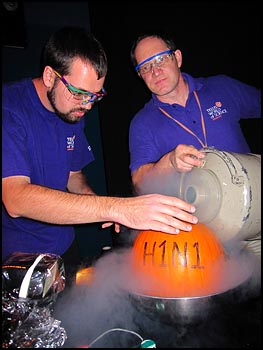
A pumpkin is frozen in liquid nitrogen by Matt Green, Staff Interpreter. left and Frank Florian, Director of Public Programs at the Telus World of Science in Edmonton on October 2, 2009. Photo by Ryan Jackson / Edmonton Journal |

Here is the setup for the frozen pumpkin shot. I built a sound trigger and plugged it into my Pocketwizard Multimax so I could set a delay from the time the sound was made till the time the flashes went off. The problem with this method is that it takes a lot of trial and error to get the time delay right and we only had three pumpkins. |
 |
 |
The sound trigger circuit is just a simple 400V SCR circuit connected to the headphone output of my audio recorder which simply acts as a mic and amplifier.
Now we move on to the exploding pumpkins! Dr. Roy Jensen with the Chemistry Department at Grant MacEwan was very excited to help me with this project. I can’t tell you what he used to blow up the pumpkins but I can say that it was in a balloon and ignited with an electric sparker. Roy also had the very important idea to score (slice) up the inside of the pumpkin with a knife so that it blew up semetrically. We also put a little bit of corn starch in the balloons to add a powdery haze.

This is actually a frame grab from my Canon XH-A1. The camera was set to 1/500th shutter speed and shot in 60i. Though it “caught the moment” the quality isn’t there.

Can you tell the difference? I was amazed what a camera shooting 10 fps can catch in an explosion. It’s not as much about the explosion (which only lasts microseconds) but the re-action after.

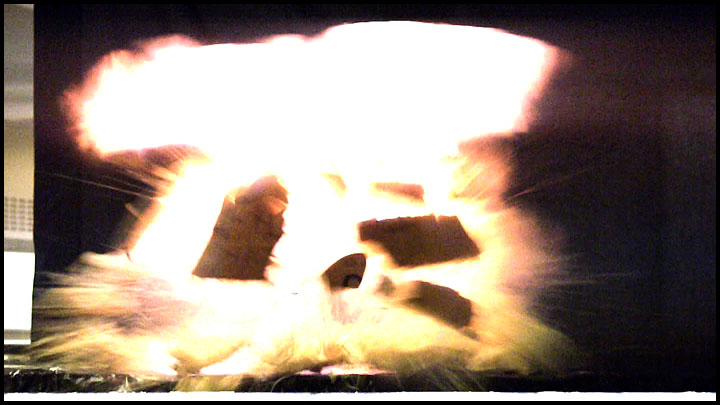
Frame grab.

Still image. Three flashes. Just awesome!


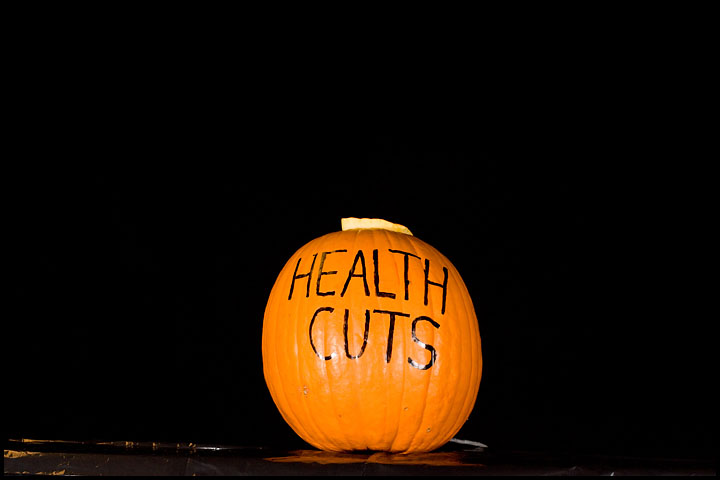

Frame grab again. The next frame after this one is at the top of this post.
For the exploding pumpkins in the MacEwan University Chemistry lab I didn’t bother with the sound trigger. Instead I just had a Canon 1D Mark-III bursting at 10 fps and a Mark-IIn bursting at 8 fps. Since the cameras have a 2 fps speed difference they fired out of sync which means I was getting about 18 fps of stills combined.
 |
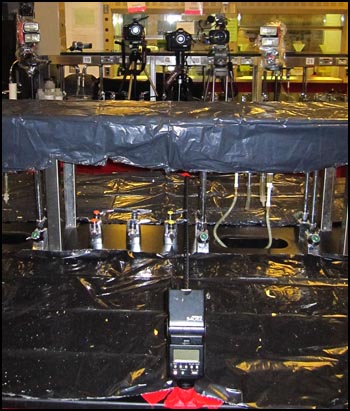 |
I doubled up the flashes so that I would only need two stands instead of four. One camera had two flashes and was triggered by Pocketwizard Flex 5’s and the other one had three flashes that were all hard wired. Both sets of flashes fired every time with no problem. The Pocketwizards fired just as good as the hard-wired flashes. The flashes were at 1/128th power and zoomed to 24mm.
The cameras were both set at 1/250th (sync) shutter speed, F22, ISO400 so there wasn’t any ambient light in the exposure. Only flash which lasted 1/35,000 sec thus freezing the explosions.

Here you can see the Canon XH-A1 video camera, the Canon 1D Mark-III and the 1D-Mark IIn. There was also a Canon HV20 video camera and a Canon SD960 IS point and shoot camera on video mode. The cameras were tiggered by Pocketwizards so I could stand a safe distance back.
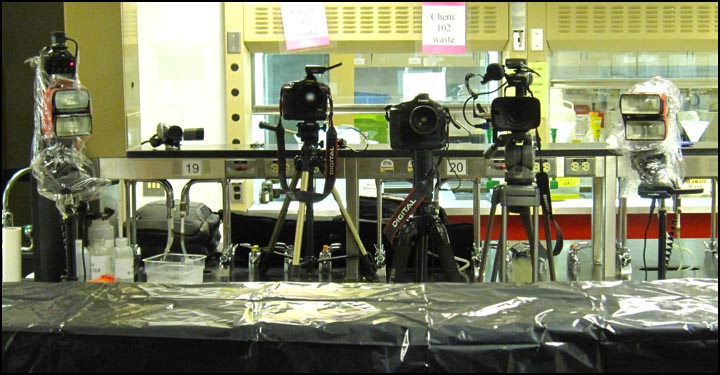
 |
 |
As you can see the pumpkins did a little damage to the ceiling. There…was….pumpkin…..EVERYWHERE!
Now for the shotgun photos.

This photo was done with two flashes. One to the left and one to the right.

This photo was ambient light at 1/2000 sec.
For the shotgun photos I did a similar setup as the exploding pumpkins. Three video cameras and two still cameras shooting a combined 18 fps.

I placed a sheet of plexy glass in front of the line of cameras incase a pellet from the shotgun went astray. (Just being paranoid.)
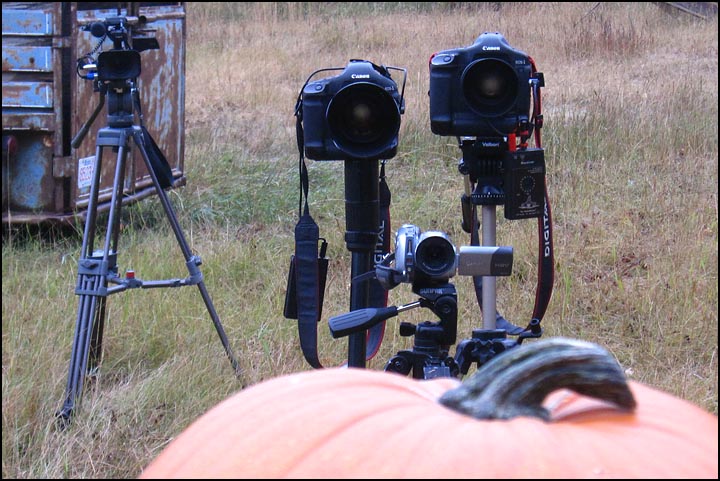

Here you can see the two video cameras (the third one was used to take this photo), the two still cameras and three flashes. One camera had two flashes and the other one only had one.
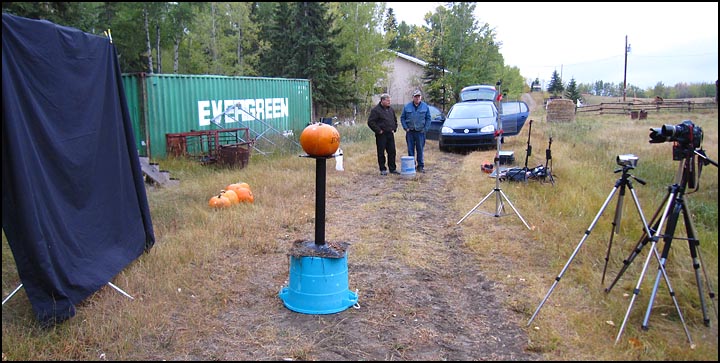
Finally you can see the black king-sized bed sheet that I used for a backround. I bought the sheet at Walmart for cheap and then draped it over a monopod superclamped to a light stand.

Good times! Watch the video




